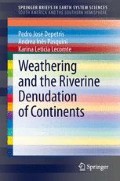Abstract
Although weathering processes are increasingly perceived as of a synergistic nature, mechanical (or physical) weathering can be viewed as the most frequent commencement of continental denudation. The action of temperature, humidity, and pressure interact to breakdown minerals and rocks, thus increasing the specific surface and facilitating the action (subsequent or concurrent) of biological and chemical agents. In order to understand the processes involved in mechanical weathering, field observations are necessary but not sufficient to fully appreciate the mechanisms of rock mechanical breakdown. In the past decade, laboratory experimentation has provided a wealth of information on the physics involved to reduce the size of outcropping rock blocks, so as to finally allow the transportation of continental rock debris to its deposition on the ocean floor, which is ultimately the final stage of the Earth’s exogenous cycle.
Access this chapter
Tax calculation will be finalised at checkout
Purchases are for personal use only
References
Aires-Barros L, Graça RC, Velez A (1975) Dry and wet laboratory tests and thermal fatigue or rocks. Eng Geol 9:249–255
Bland W, Rolls D (1998) Weathering: an introduction to the scientific principles. Arnold, London
Camuffo D (1995) Physical weathering of stones. Sci Total Environ 167:1–14
Cary Eppes M, McFadden LD, Wegmann KW et al (2010) Cracks in desert pavement rocks: further insights into mechanical weathering by directional insolation. Geomorphology 123:97–108
Dorn RI (2011) Revisting dirt cracking as a physical weathering process in warm deserts. Geomorphology 135:129–142
Hall K (1995) Freeze-thaw weathering: the cold region “Panacea”. Polar Geogr 19(2):79–87
Hall K (1999) The role of thermal stress fatigue in the breakdown of rock in cold regions. Geomorphology 31:47–63
Hall K, André MF (2001) New insights into rock weathering from high-frequency rock temperature data: an Antarctic study of weathering by thermal stress. Geomorphology 41:23–35
Matsuoka N, Murton J (2008) Frost weathering: recent advances and future directions. Permafrost Periglac Process 19:195–210
Papida S, Murphy W, May E (2000) Enhacement of physical weathering of building stones by microbial populations. Int Biodeterior Biodegrad 46:305–317
Schwamborn G, Schirrmeister L, Frütsch F, Diekmann B (2012) Quartz weathering in freeze-thaw cycles: experiment and application to the El’gygytgyn Crater Lake record for tracing Siberian permafrost history. Geogr Ann A Phys Geogr 94(4):481–499
Scott KM, Pain CF (eds) (2009) Regolith science. Springer, Dordrecht
Wallder JS, Hallet B (1986) The physical basis of frost weathering: toward a more fundamental and unified perspective. Arct Alp Res 18(1):27–32
White SE (1976) Is frost action really only hidration shattering? A review. Artc Alp Res 8:1–6
Weber S, Gruber S, Girard L (2012) Design of measurement assembly to study in situ rock damage driven by freezing. In: Hinkel KM (ed) Proceedings of the 10th international conference on permafrost, vol 1. TICOP, Salekhard
Weiss T, Siegesmund S, Kirchner D et al (2004) Insolation weathering and hygric dilatation: two competitive factors in stone degradation. Environ Geol 46(3–4):4012–4413
Yavuz H, Altindag R, Sarac S et al (2006) Estimating the index properties of deteriorated carbonate rocks due to freeze-thaw and thermal shock weathering. Int J Rock Mech Min Sci 43:767–775
Author information
Authors and Affiliations
Corresponding author
Glossary
- Albedo:
-
The reflectivity coefficient of a surface to short-wave radiation, i.e., the fraction of incoming solar radiation that is reflected rather than absorbed, from the Earth back into space. A value of 0 means the surface is a “perfect absorber” and a value of 1 means the surface is a “perfect reflector.”
- Anhydrous:
-
A substance free from water, especially water of crystallization.
- Biosphere:
-
Part of the Earth’s crust, waters, and atmosphere that supports life; the global sum of all ecosystem that interact within the elements of the lithosphere, hydrosphere, and atmosphere.
- Electro-osmosis:
-
a.k.a. electro osmotic flow, i.e., the motion of water or any other liquid induced by a potential across a porous material, capillary tube, or any other fluid conduit.
- Exfoliation:
-
Surface-parallel fracture systems in rock often leading to erosion of concentric slabs.
- Haloclasty:
-
A type of physical weathering caused by the growth of salt crystals. The process is first started when saline water seeps into cracks and evaporates depositing salt crystals, when the rocks are then heated, the crystals will expand putting pressure on the surrounding rock which will over time splinter the stone into fragments.
- Hydrate:
-
A substance that contains water of crystallization or water of hydration, in a definite ratio as an integral part of the crystal.
- Lithosphere:
-
Rigid outermost shell of a rocky planet. On Earth, it comprises the crust and the portion of the upper mantle. It continually interacts with the atmosphere and hydrosphere. It is broken into about a dozen separate, rigid blocks, or plates.
- Regolith:
-
Layer of loose heterogeneous material covering solid rock. It includes dust, soil, broken rock, and other related materials and is present on Earth, the Moon, Mars, some asteroids, and other terrestrial planets and moons.
- Tafoni:
-
Cave-like features found in granular rock with rounded entrances and smooth concave walls.
- Thermal fatigue:
-
The progressive and localized structural damage that occurs when a material is subjected to repeated heating and cooling. If the loads are above a certain threshold, microscopic cracks will begin to form at the stress concentrators such as the surface, persistent slip bands, and grain interfaces. Eventually a crack will reach a critical size, and the structure will suddenly fracture; materials do not recover when rested.
Rights and permissions
Copyright information
© 2014 The Author(s)
About this chapter
Cite this chapter
Depetris, P.J., Pasquini, A.I., Lecomte, K.L. (2014). The Commencement of Continental Denudation: Mechanical Weathering. In: Weathering and the Riverine Denudation of Continents. SpringerBriefs in Earth System Sciences. Springer, Dordrecht. https://doi.org/10.1007/978-94-007-7717-0_2
Download citation
DOI: https://doi.org/10.1007/978-94-007-7717-0_2
Published:
Publisher Name: Springer, Dordrecht
Print ISBN: 978-94-007-7716-3
Online ISBN: 978-94-007-7717-0
eBook Packages: Earth and Environmental ScienceEarth and Environmental Science (R0)

